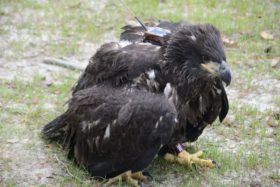Banding the NBG Eaglets March 31
Azalea Visiting Research Station in NC
March 29, 2010Eaglets to Get ID Bracelets
March 30, 2010To our WVEC Eagle Cam Viewers
Several viewers have expressed concerns about the banding of the bald eagle chicks on Wednesday March 31 and we do hear you and appreciate your interest in these eagles. The three of us, Dr Bryan Watts, Libby Mojica and myself, who will be involved in the banding have combined over 80 years experience working with and banding raptors. Our lives have been dedicated to learning about and teaching others about their lives and how we can best live with them in our world. Please read the statement below from Dr Watts. I hope you will understand that the health and safety of these birds is always our first concern. – Reese Lukei, Jr
———————
I wanted to write to assure everyone interested in the Norfolk Botanical Gardens bald eagle nest that the banding event on Wednesday will be safe for the birds and with the forecast of good weather should be a great event for observers.
Other than the obvious issues of disturbance, nest condition, etc., there are two major milestones that we evaluate when considering whether or not it is safe to band chicks. The first is whether or not the chicks are old enough to thermoregulate on their own. When eaglets hatch they are not able to maintain their own temperature without warmth from the adults. That is why the female is consistently present and broods closely during cool days and nights. Disturbance should be kept to a minimum during this period since flushing the female away from the nest may leave the chicks vulnerable to exposure. However, the chicks reach a physiological transition around 14-15 days of age when they are able to maintain their own temperature. This milestone is typically linked to a change in the female’s behavior and she begins to assist with hunting and does not brood except during rainy or very cool periods. The second milestone is whether or not the birds can “hold” a band. If the chick’s feet are small enough to allow the band to slip down over the foot this may lead to problems in development. The fleshy parts of the feet of most raptors grow to adult size well before most other body parts. This allows them to reach another important milestone which is self-feeding at a very young age compared to other activities such as flying. Because of their rapid growth, eaglets that are 15 to 16 days of age are easily able to hold bands.
Although we are able to safely band eaglets over a wide range of ages including near fledging, likely the ideal time window (if we are just banding) is between 18 and 28 days. At this age, the chicks have reached important safety milestones but are very complacent and pliable. Chicks of this age mostly eat and sleep and so often sleep through the banding event and wake up back in the nest. Banding at this age is safer for both the chicks and the banders.
Sincerely,
Bryan D. Watts, Ph.D.
Mitchell A. Byrd Professor of Conservation Biology
Director, Center for Conservation Biology
College of William and Mary
Virginia




8 Comments
good to know!….thanks
Thank you ALL for everything. I have every confidence in your decision and am sorry some do not understand. Thanks for this info – good to know this.
Thank you for all the informatioin, I have never doubted that the eaglets were in good hands with you. Have this extra information to share with my frist grade students is wonderful. We are on spring break now and I plan to come and watch and hope to have some good photos to take back to my class next week. THANKS for all you do to educate all of us!!
It all makes sense now. Thanks for taking the time to explain. I’ll be teaching tomorrow, too, and we can’t get the websight on the classroom computers but we’ll be talking about it and we’ll be eager to get home to check on the babies.
Hi Reese. Thank you very much for posting Dr Watts’ statement. It must be hard conducting science with the need to spend so much time in the public eye, on public relations. I’ve never questioned the decision about when to band the eaglets…after all, you all are the experts!…but since i’m always in search of more knowledge, it was very interesting to read his detailled discussion of the pros and cons of earlier banding. The YouTube video of the 2007 banding that you posted was fascinating…i would not be at all comfortable up in the tree (i.e. scared to death of that kind of height!), but would have loved to have been in the ground crew settling the chicks and banding them! Am really looking forward to this year’s event and hope the cam will be up by then…if not, will enjoy your pics and videos after the fact.
Thanks for this info. I do understand what you are saying. I just feel that it could have waited until they were at least another week older.
Thank you for the information, so that I can quit worrying that they are too young! I know they will be in good hands, literally and figuratively.
Thanks for the explanation about the (early) banding.
Leaves me with one question: Why then were the chicks of previous years banded at an older age ?